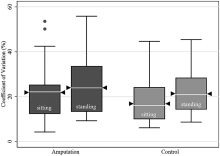Energy expenditure (EE) is often greater in people with lower-limb amputation, compared with healthy controls, because of the biomechanical compensations needed to walk with a prosthesis. Compensatory movements are required to stand with a prosthesis; however, little is known about whether standing with a prosthesis also requires greater EE.
The goal of this study was to examine the effect of standing and sitting positions on EE in people with transtibial amputation and matched controls.
Energy expenditure data from people with unilateral, transtibial amputation because of nondysvascular causes were compared with data from age- and sex-matched controls without amputation. Energy expenditure was defined as the mean volumetric rate of oxygen consumed over the last 2 of 5 minutes in each position and measured with a portable breath-by-breath metabolic analyzer. Repeated-measures analysis of variance was used to examine the effects of position (sitting and standing) and group (amputation and control) on EE.
A significant interaction effect indicated participants with amputation showed a significantly greater increase in standing EE relative to sitting EE (26.2%) than did controls (13.4%). Simple main effects showed EE in standing was significantly greater than EE in sitting for both groups, but there were no significant differences in EE between groups during sitting or standing.
Energy expenditure in standing, when measured relative to EE in sitting, is significantly greater in people with amputation. This result indicates that additional energy may be required to maintain an upright position with a lower-limb prosthesis.
